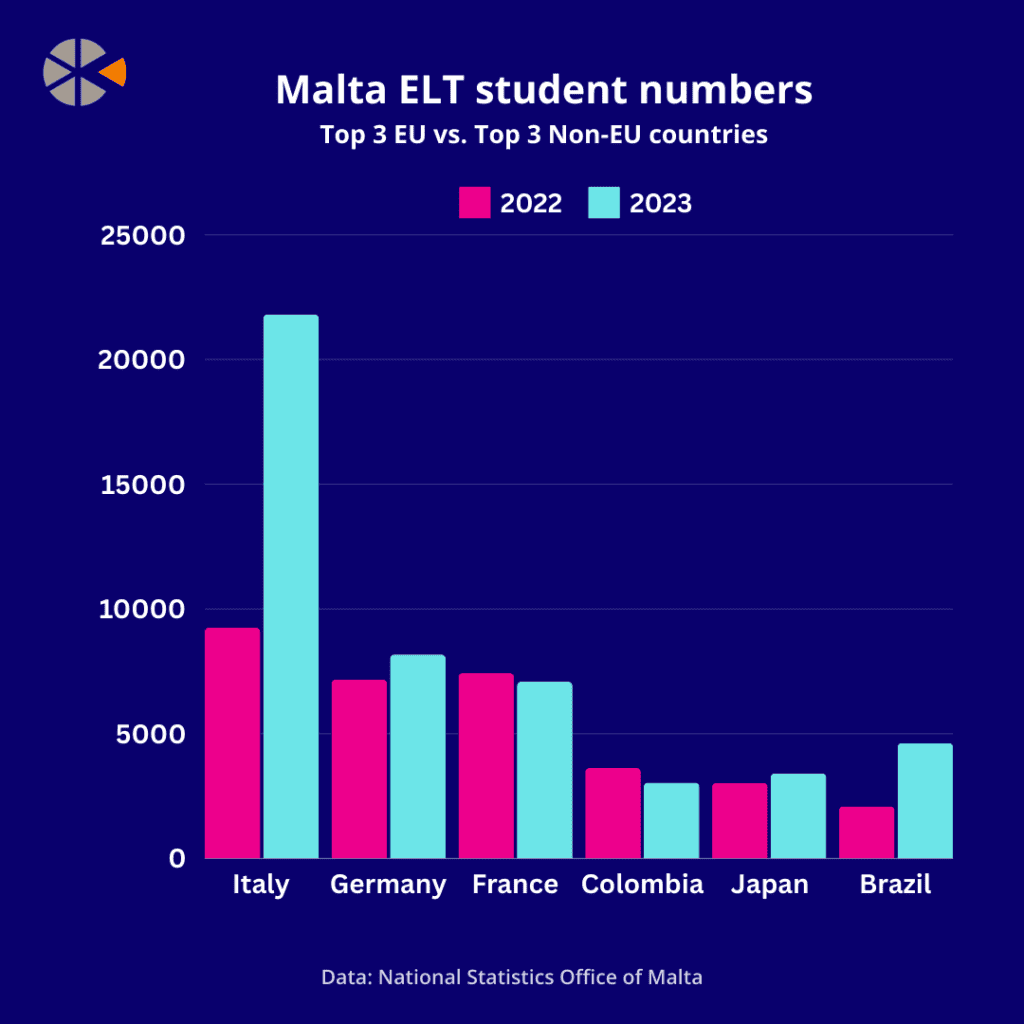Malta’s international student numbers in English language schools rose again in 2023, with Italy’s numbers more than doubling its market share, according to new data.
The National Statistics Office of Malta revealed on May 20 that it had a grand total of 78,567 students studying English language courses at licensed ELT schools in the country, marking a 21% rise on 2022 when 56,675 were on the island.
In the EU, the top three sending countries were Italy, Germany and France.
- A surprise jump was seen by the Italian source market, which went from sending 9,245 in 2022 to a staggering 21,808 in 2023 – accounting for over a quarter (27.8%) of all overseas students studying English in Malta
- Germany accounted for 10.4% of students, with 8,174
- France’s figures dropped slightly from 2022, going from 7,427 to 7,081 – 9% of the 2023 total.
Italy’s number was its highest ever, beating its previous record figure of 18,335 in 2019.
Also notably faring well from the EU was Austria, which also more than doubled its numbers to just shy of 5,000 students, and Hungary broke the 1,000 mark, going from 821 to 1,076.
Looking outside of the EU, Brazil has overtaken both Japan and Colombia to be the top sending country, more than doubling its student numbers from just over 2,000 to 4,623.
Colombia and Japan have switched places near the top of the table – last year, Colombia was the biggest sending country with 3,623 students to Japan’s 3,029.
In 2023, the tables have turned, with Colombia’s numbers the third biggest share of non-EU students with 3,036, and Japan staying in second with 3,407.

While numbers for China have recovered somewhat between 2022 and 2023 – going from 294 to 429 they are still modest for Malta and don’t meet its 2019 level of 539.
At the IH Directors Conference in Split on May 20, hours before Malta’s numbers were released, BONARD’s international education director Ivana Bartosik said China’s appetite for English language study in many destinations was demonstrating a slow recovery – especially considering Colombia is forecasted to be the top sending country worldwide for English language study in 2023; it was China in 2019.
“I believe the debate is around whether [China] will ever come back to what it used to be… it’s not very likely, but let’s see,” she told delegates.
South Korea also saw a drop below 1,000 students to just 940 in 2023.
In terms of student weeks, 2023 saw a total of 273,131 across all nationalities, smashing the record in 2022 of 246,314.
“The average number of student weeks during the year… stood at 3.5, a decrease of 0.9 weeks when compared to the previous year,” the NSO noted.
I believe the debate is around whether [China] will ever come back to what it used to be
Ivana Bartosik, BONARD
Providing the single most student weeks was Colombia with almost 44,713 total weeks, which was down from its 2022 total of 52,678. Italy’s have skyrocketed from 18,814 to 33,075 weeks.
It comes after a snapshot in 2023 was warning that challenges “still remained” to maintain student numbers.
Losing some ground was Japan, whose 25,441 weeks dropped to just 21,337. Despite strong student numbers uniquely listed, Brazil’s individual student weeks were not specified.
Colombian, South Korean and Chilean students, however, recorded the highest number of student weeks per student; Colombians averaged 14.7, while Chileans averaged 13.3 and South Koreans 10.7 weeks.
“The largest share of English language students were aged 15 and under, accounting for 28.3% of the total students… students aged 50 and over were in the minority,” the NSO added on the age range of the students.
Italy’s 15 and under age group and 16-17 age group total student weeks total spiked from 5,188 to 12,489 and 4,812 to 10,442 respectively, possibly explaining the big jump in numbers.
It also noted July was the busiest month for schools with 17% of the annual total, while August and March followed with 13% and 10.5% respectively.











